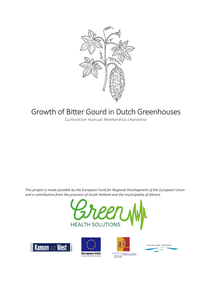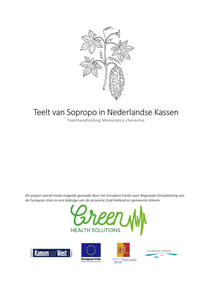Bitter gourd is also called sopropo, balsam-pear, karela or bitter melon and is a member of the cucumber family (Cucurbitaceae). It is a monoecious, annual, fast-growing and herbaceous creeping plant. The wrinkled fruit of the bitter gourd is consumed as a vegetable and medicine in Asia, East Africa, South America and India. The aim of this bitter gourd cultivation manual is to make this cultivation accessible to Dutch growers and in this way be able to meet market demand. In addition, this cultivation manual aims to provide insight into the standardized production of the medicinal ingredients in the fruit.
DOCUMENT

Er wordt aangenomen dat het proeven van een bittere smaak in de evolutie van de mens is ontwikkeld als hulpmiddel om giftige planten en andere ongewenste stoffen te herkennen. Maar hoe komt het dan dat de ene persoon bitter lekker vindt en de ander de smaak ervaart als ondraaglijk? Studenten van Hogeschool lnholland zochten uit hoe het zit met de waarneming, beleving en gewenning van de smaak bitter.
LINK
Understanding taste is key for optimizing the palatability of seaweeds and other non-animal-based foods rich in protein. The lingual papillae in the mouth hold taste buds with taste receptors for the five gustatory taste qualities. Each taste bud contains three distinct cell types, of which Type II cells carry various G protein-coupled receptors that can detect sweet, bitter, or umami tastants, while type III cells detect sour, and likely salty stimuli. Upon ligand binding, receptor-linked intracellular heterotrimeric G proteins initiate a cascade of downstream events which activate the afferent nerve fibers for taste perception in the brain. The taste of amino acids depends on the hydrophobicity, size, charge, isoelectric point, chirality of the alpha carbon, and the functional groups on their side chains. The principal umami ingredient monosodium l-glutamate, broadly known as MSG, loses umami taste upon acetylation, esterification, or methylation, but is able to form flat configurations that bind well to the umami taste receptor. Ribonucleotides such as guanosine monophosphate and inosine monophosphate strongly enhance umami taste when l-glutamate is present. Ribonucleotides bind to the outer section of the venus flytrap domain of the receptor dimer and stabilize the closed conformation. Concentrations of glutamate, aspartate, arginate, and other compounds in food products may enhance saltiness and overall flavor. Umami ingredients may help to reduce the consumption of salts and fats in the general population and increase food consumption in the elderly.
MULTIFILE

Taste is a main driver in preferences and food choices. Humans are predispositioned to prefer sweet and salty tastes and reject bitter and sour tastes, therefore bitter taste is often thought to cause the rejection of vegetables by children. In our study we investigated the taste and fattiness intensity for different preparation methods for ten vegetables. Our results showed that: Frequently consumed vegetables have almost no taste Sweetness is the most intensive taste in vegetables, followed by sourness and bitterness, saltiness is the least intensive taste Vegetable preparation method influences taste intensity
DOCUMENT

Welke rol heeft de politie in de samenwerking met het zorgdomein, vooral rond mensen met meerdere en complexe problemen? In het project GIPZ onderzochten we dit samen met politie- en zorgprofessionals in de regio Midden-Nederland.
DOCUMENT

In het themanummer ‘Politiefunctie en politietaak’ van het Tijdschrift voor de Politie beschrijven wij 6 spanningen in de samenwerking tussen politie en zorg in acute situaties. Ook geven we richting aan vervolgstappen. Dit is gebaseerd op ons onderzoek GIPZ – Gezamenlijke Inspanning Politie en Zorg.
MULTIFILE

Enhancing sweetness of vegetables by addition of sucrose or sweeteners can increase acceptance but is not necessarily desirable. An alternative strategy could be to combine vegetables with other vegetables. By offering combinations of vegetables it might be possible to suppress bitterness, enhance sweetness and provide texture variety leading to increased acceptance. The aim of this study was to determine the influence of combining vegetables with other vegetables on sensory properties and acceptance. Carrot (sweet), cucumber (neutral), green bell pepper (bitter) and red bell pepper (sour) were assessed individually and in combination with the other three vegetables in two mixing ratios (1:2 and 2:1). Additionally, four combinations of three vegetables (mixing ratio 1:1:1) were assessed. A trained panel (n = 24) evaluated taste, flavour and texture and a consumer panel (n = 83) evaluated acceptance of all vegetables and combinations. Combining green bell pepper with carrot (1:2 and 2:1) increased sweetness and decreased bitterness. Combining cucumber, carrot or red bell pepper with green bell pepper (1:2) increased bitterness. Mainly sweetness and bitterness were associated with acceptance whereas texture (crunchiness, firmness and juiciness) did not strongly influence acceptance. Cucumber was the most accepted vegetable followed by carrot, red bell pepper and green bell pepper. Acceptance of vegetable combinations can differ from acceptance of individual vegetables depending on vegetable type and mixing ratio. Only 3 of 16 vegetable combinations had higher acceptance compared to the least accepted vegetable in the combination and similar acceptance as the more accepted vegetable in the combination. For 13 of 16 vegetable combinations acceptance did not increase compared to acceptance of individual vegetables. These findings suggest that strategies aimed at increasing vegetable consumption can be devised using specific combinations of vegetables.
DOCUMENT

Sopropo wordt ook wel bitter gourd, balsempeer, karela of bittermeloen genoemd en is lid van de komkommerfamilie (Cucurbitaceae). Het is een eenhuizige, eenjarige, snelgroeiende en kruidachtige klimplant. De gerimpelde vrucht van de bitter gourd wordt in Azië, Oost-Afrika, Zuid-Amerika en India geconsumeerd als groente en medicijn. Alhoewel de sopropo nog niet bekend is in de Nederlandse keuken, kan dit zeker een aanwinst zijn in de huidige trend om voeding te gebruiken als medicijn. Het doel van deze teelthandleiding van sopropo is het toegankelijk maken van deze teelt voor Nederlandse telers en op deze wijze te kunnen voldoen aan de marktvraag. Daarnaast heeft deze teelthandleiding als doel inzicht te geven in de gestandaardiseerde productie van de medicinale inhoudsstoffen in de vrucht.
DOCUMENT

Bitterness has been suggested to be the main reason for the limited palatability of several vegetables. Vegetable acceptance has been associated with preparation method. However, the taste intensity of a variety of vegetables prepared by differentmethods has not been studied yet. The objective of this study is to assess the intensity of the five basic tastes and fattiness of ten vegetables commonly consumed in the Netherlands prepared by different methods using the modified Spectrum method. Intensities of sweetness, sourness, bitterness, umami, saltiness and fattiness were assessed for ten vegetables (cauliflower, broccoli, leek, carrot, onion, red bell pepper, French beans, tomato, cucumber and iceberg lettuce) by a panel (n = 9) trained in a modified Spectrum method. Each vegetable was assessed prepared by different methods (raw, cooked, mashed and as a cold pressed juice). Spectrum based reference solutions were available with fixed reference points at 13.3 mm (R1), 33.3mm(R2) and 66.7mm(R3) for each tastemodality on a 100mmline scale. For saltiness, R1 and R3 differed (16.7 mm and 56.7 mm). Mean intensities of all taste modalities and fattiness for all vegetables were mostly below R1 (13.3 mm). Significant differences (p b 0.05) within vegetables between preparation methods were found. Sweetness was the most intensive taste, followed by sourness, bitterness, fattiness, umami and saltiness.In conclusion, all ten vegetables prepared by different methods showed low mean intensities of all taste modalities and fattiness. Preparation method affected taste and fattiness intensity and the effect differed by vegetable type.
DOCUMENT

Jongvolwassenen (16-27 jaar) met politie- en justitiecontacten en problemen op meerdere leefgebieden vormen een complexe groep voor Nederlandse gemeenten. Deze groep is verantwoordelijk voor een onevenredig groot aandeel van de criminaliteit en maakt langdurig gebruik van verschillende gemeentelijke voorzieningen. Voor professionals zijn deze jongvolwassenen moeilijk te bereiken en te motiveren voor zorg- en/of strafrechtelijke trajecten. Sinds een aantal jaren wordt, binnen de zogenoemde Lokale Persoonsgerichte Aanpak (Lokale PGA), in veel gemeenten domeinoverstijgend samengewerkt om de complexe problematiek zoals bij deze jongvolwassenen te adresseren en adequate interventies in te zetten. De Lokale PGA betreft een integrale aanpak, toegesneden op de persoon en zijn systeem, waarbij een combinatie van bestuurlijke, strafrechtelijke, zorg- en overige interventies wordt ingezet. Geprobeerd wordt om hardnekkige patronen van criminaliteit en overlast te doorbreken en herhaling te voorkomen.
DOCUMENT
